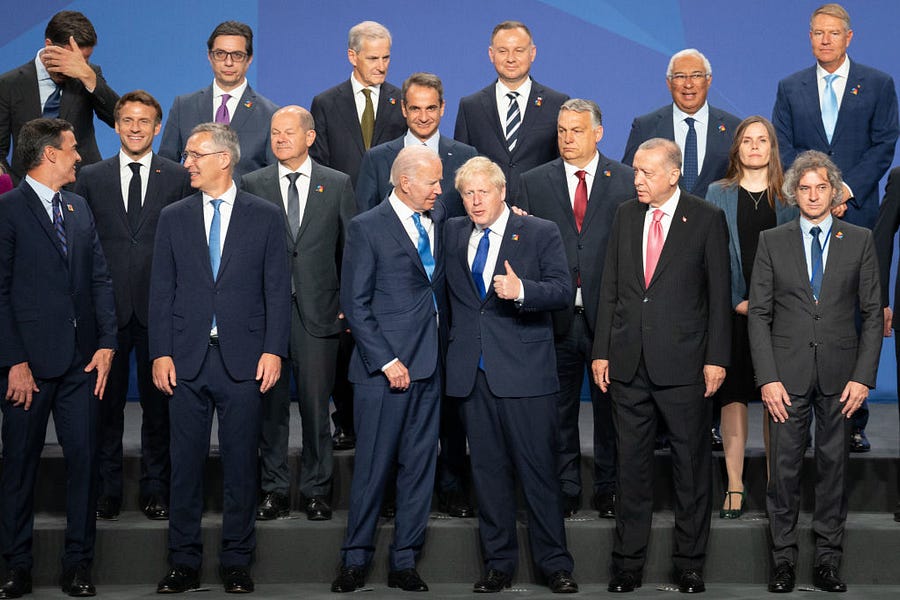Just a few years ago, French President Emmanuel Macron called NATO “brain dead” and U.S. President Donald Trump said NATO was “obsolete.” Today, the alliance is more relevant than any time since the end of the Cold War. At last week’s NATO summit in Madrid, the alliance issued a formal Strategic Concept that is striking for its coherence and focus.
While there is much to be done to make that Strategic Concept a reality materially and operationally, the fact that 30 member states agreed that “the Euro-Atlantic area is not at peace,” that “the Russian Federation is the most significant and direct threat to Allies’ security and to peace and stability,” and that one “cannot discount the possibility of an attack [by Russia] against Allies’ sovereignty and territorial integrity” is light years away from what would have been agreed to by Paris, Berlin, and Rome just a year ago. Nothing like a large-scale military invasion in the neighborhood to concentrate the alliance’s mind.
The intent is to greatly expand the alliance’s conventional military capabilities and, in turn, its ability to deter further Russian aggression. Adding Sweden and Finland, with modern and capable militaries, to the fold is important, in addition to setting a goal of having 300,000 rapid-reaction forces on hand to deploy when needed. Already the Biden administration has committed to stationing permanently an Army corps headquarters forward command post in Poland, with a support battalion, and retaining an Army rotational armor and air-combat brigades. The Army will also rotate a combat brigade team in Romania. For the Baltics, the Pentagon will be increasing its rotational armor, aviation, air defense and special operation forces. The Air Force will be forward stationing two squadrons of stealthy F-35s in the United Kingdom. In Germany, the Army will be adding air defense units and support elements, while also deploying a short-range defense battery in Italy. And, finally, the Navy wants to expand the number of destroyers stationed at the Spanish naval base at Rota by two.
Not that the alliance has been simply sitting on its hands since the first Russian invasion of Ukraine in 2014. Key alliance powers, including the U.K., France and Germany, along with the U.S., rotated “tripwire” forces in each of the Baltic states. NATO established new operational and logistic commands, put forward new initiatives in cyber warfare, pushed deployments into Southeast Europe and the Black Sea, and tripled the size of its high-readiness, Joint Force to some 40,000 troops.
NATO has even made progress on what allies spend on defense. Combined, member states have increased defense spending for the past seven years, with 2022 likely an eighth year even in the wake of the economic crisis caused by the pandemic. Since 2014, U.S. allies in total added more than $200 billion to their defense budgets and, just as significantly, far more of those added monies went into procuring weapons and supplies.
That said, NATO is still well short of what it needs to solidify its deterrent vis a vis Russia. It remains short on alliance-wide logistic support, air transport, electronic warfare, air defenses, ammunition stocks, and even roads and bridges capable of moving and handling large numbers of forces from Western and Central Europe to the East.
However, the most pressing problem facing NATO in the years ahead is that, while the U.S. military remains the world’s preeminent military, it no longer is decisively dominant. Since 2012, the Pentagon has been publicly clear that it does not have the capacity to handle two simultaneous major conventional wars. This means in turn that the American military’s conventional deterrent posture can be effective only at one end of the Eurasian landmass at a time and, since 2012, successive administrations have made it clear that they want to put most of the military eggs in the Indo-Pacific basket to meet the even greater security threat posed by China. This doesn’t mean that Washington will not keep to its commitments coming out of Madrid to add more forces to the European theater, but it does mean, absent a 180 degree turn by the Biden team on what it plans for defense spending, that the announced measures will likely be about all there is. European allies will simply have to spend more if NATO is to meet its goals.
Key here is Germany, the continent’s largest economic power and, outside of Turkey and Russia, the largest in population. On the one hand, in the aftermath of the first Russian invasion of Ukraine in 2014-15, Germany increased its defense spending by one-third. Now, in the wake of the second Russian invasion, the coalition government in Berlin announced it had reached Zeitenwende—a historic turning point—in its defense policy. To give substance to that change, the government moved to amend the German constitution to allow it to create a €100 billion fund for new military investments and acquisitions. Among the announced acquisitions will be the American F-35s. This was a reversal of an earlier decision to postpone acquiring an advanced stealth jet until a European consortium had developed its own—a process that would not have come to fruition (at best) until the late 2030s. Filling in holes in supplies, ammo, air defense, and helicopter lift, Germany will be spending more than 2 percent of its GDP on defense for the first time since 1991.
On the other hand, with the €100 billion being a special budget item, there has been little said about sustaining a buildup after this money is spent. Indeed, the extra money will go rather quickly if the proposed acquisitions go forward, especially because much of the €100 billion could go just to digging the German military out of the readiness hole it is currently in.
A truly transformational change will require an equally significant shift in German political culture regarding military matters. Angela Merkel avoided addressing the topic and, typically, handed the defense ministry to members of her cabinet with little political pull. In the aftermath of the first invasion in 2014, German elites spoke of a need for their country to step up and play a larger role in maintaining the international order Germany benefited from. But Merkel’s lack of leadership dissipated this so-called Munich Consensus. In 2023, the German government will produce what many are calling the country’s first national security strategy. It could provide the road map to make Zeitenwende more than a word. Yet, without sustained resources and political backing, it will be just another blip in post-war German history.
Germany, of course, is not alone in doing too little to support its military. The fact is, other than the Poles, who recently announced their defense budget would increase to 3 percent of its GDP, the major military powers in the alliance, including the U.K. and France, fall substantially short of the funding to meet their own stated strategic plans. By any honest assessment, NATO’s guideline that members spending 2 percent of GDP on defense should be seen as the bare minimum for member states, not a goal. Modern militaries are expensive and 3 percent of a nation’s GDP should not be seen as an unreasonable burden.
While NATO’s to-do list is substantial, none of the problems facing NATO are insurmountable. Nor are the problems any less serious than past challenges. Lost in the discussions about the alliance’s difficulties and shortcomings is the success that NATO has made in the past to adjust to the changing security environment from the start of the Cold War to its end. The alliance’s adaptations, most often made at Washington’s request, go largely unremarked on. Left aside also is the actual increase in “hard power” that individual allies have provided the U.S. in every major conflict it has been involved in since World War II—contributions that are largely made possible by the working relationships that have become institutionalized precisely because NATO exists. And, to cut to the chase, does anyone think that Europe’s response to the most recent invasion of Ukraine, as uneven as it has been, would be as substantial in the absence of NATO’s Article 5 security guarantees?
The Madrid summit will be judged not only by the goals it has set but by what the allies accomplish or fail to accomplish to meet them. But it is useful to remember here, given what we know about the alliance and its workings over the past seven decades, that NATO is not, and never will be, a thoroughbred racehorse. Rather, it’s more like a mule, often slow to move, often stubborn in its ways, but given a persistent push from Washington, capable of carrying a considerable security burden on its back.
Gary Schmitt is a senior fellow at the American Enterprise Institute, where he writes on constitutional and national security issues.






Please note that we at The Dispatch hold ourselves, our work, and our commenters to a higher standard than other places on the internet. We welcome comments that foster genuine debate or discussion—including comments critical of us or our work—but responses that include ad hominem attacks on fellow Dispatch members or are intended to stoke fear and anger may be moderated.
With your membership, you only have the ability to comment on The Morning Dispatch articles. Consider upgrading to join the conversation everywhere.